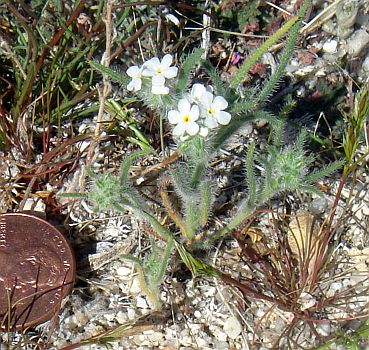Bloom Reports from the Anza-Borrego Desert: 2011-2012
 |  |
| Pictures taken on 9 February 2012 in Bisnaga Alta Wash between the Vallecito and Carrizo Valleys. Both species are often ten times larger in better rainfall years, with many more flowers (note the even smaller cryptantha at the lower left of the picture that will probably have even fewer blooms). Without further rainfall, these are essentially all the flowers these plants are going to produce. Tom walked right by 20 plants of this purple mat that were in bloom without even noticing them.
The cryptantha was found immediately beside S2, which had germination from the extra water that ran off the road. The purple mat was found in only two small spots in a survey of several miles of the wash, in spots where water was probably more plentiful. In poor rainfall years like this, the best place to look for annuals is in such wetter spots. See also Michael Charters' Photo Gallery from Bisnaga Alta Wash on 2/9/12 and Pictures shown here on prior dates. | |
See Bloom Reports from the Anza-Borrego Desert for an introduction to this page, extensive general information (not specific to this year) about Annual Germination, Growth and Blooms, including what influences the duration and extent of the annual bloom, photo galleries, and links to other webpages giving information on Anza-Borrego Desert State Park Blooms.
Summary of Annual Germination, Growth and Blooms in 2011-2012
In the southern part of ABDSP, in Mason Valley and southward, at elevations of 1000 to 2000 feet, we are now entering peak bloom, such as it is in this poor rainfall year.
In all of our trips so far this year, we've now seen 67 annual species, and 157 species total, in bloom. This represents about 3/4 of all the species that bloom in a typical year, and probably a higher percentage of the species that will bloom this year.
This year there are no carpets of flowers, and few, if any, showy displays. Instead, in the areas where moisture was greatest, primarily along roadsides, in canyon bottoms and in washes, we have many tiny annuals each producing just a few flowers, which will quickly go to seed without further rain.
Although tourists may complain about the lack of blooms, botanists will be delighted that there are still so many species to be found in bloom, at least in some favored locations. For example, we observed over 1,871 plants of 67 species in bloom on 2/9/12 in Bisnaga Alta Wash and nearby.
In the northern part of ABDSP, such as in the town of Borrego Springs and eastward, few annuals even germinated this year, so the bloom there is almost non-existent. Not even botanists will be happy there.
This north-south variation in the low desert was the result of rainfall that occurred only on 12 November and 12 December 2011 that was greatest in the southern part of ABDSP. The rainfall was probably even higher in Baja California, since it came from an unusual series of cut-off lows that each went across Baja California.
The following pictures show just how bad it was on 18 January 2012 at the beginning of the Hellhole Canyon Trail; at the junction of the Hellhole Canyon Trail and the California Riding and Hiking Trail; at about a half mile up the California Riding and Hiking Trail; and in Little Surprise Canyon. In those pix, germination was only seen in Little Surprise Canyon. There has been no rainfall in any of these areas since those pictures were taken, so it is unlikely anything has changed in those locations.
There are desert areas outside of ABDSP that had good blooms in January 2012, from heavy rainfall in September and October 2011, such as lowermost Box Canyon immediately east of Mecca, and the southern boundary of Joshua Tree National Park on Cottonwood Springs Road. RT Hawke discovered both of these areas, fairly limited in size, where much water ponded above dikes. RT Hawke reported on 2/13/12 that upper Box Canyon was in the middle of full bloom, with 64 species in bloom.
There are also plenty of desert areas outside of ABDSP with few blooms. RT Hawke reported on 2/13/12 that Mission Creek Reserve had very little in bloom, and on 2/5/12 that the PCT from Cottonwood trail head to Whitewater looked very dry, with just 38 species in bloom of mostly few individuals.
See also:
- Detailed Germination, Growth and Bloom Reports From Each Hike: 2011-2012.
- Pictures From Each Hike: 2011-2012.
- Number of Species and Plants in Bloom On Each Trip: 2011-2012.
- List of Species in Bloom On Each Trip, With Photographs: 2011-2012.
Predictions for This Year
Without further rainfall in the desert, the annual bloom is going to end relatively quickly at elevations of 1000-1500 feet, and might be gone by March. Annuals at higher elevations will probably be in bloom in March, and gone by April.
However, we are hoping for another Miracle March, which produces another round of germination, so we can study numerically what happens under those conditions.